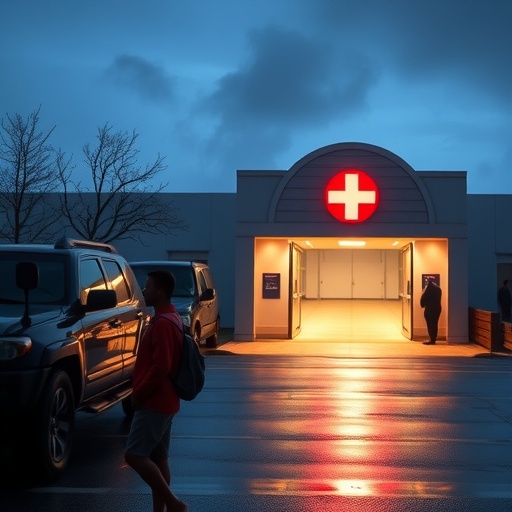A groundbreaking new study from the University of Michigan reveals a troubling intersection between health insurance status and survival outcomes among critically ill patients suffering from acute respiratory failure. The investigation, spearheaded by Drs. Emily Harlan and Thomas Valley from the Division of Pulmonary and Critical Care Medicine, uncovers significant disparities in inter-hospital transfer rates that appear to hinge largely on the type of insurance coverage patients hold. Their findings illuminate systemic inequities that may influence which patients are afforded access to higher-level care, potentially altering life-or-death outcomes.
Inter-hospital transfer—the process by which critically ill patients are moved from one hospital to another with specialized resources—has long been understood to benefit patients requiring complex interventions. Specialized high-volume centers, particularly those adept at managing ventilated patients, have demonstrated improved survival rates in numerous studies. However, the criteria guiding these transfers have remained opaque, with insurance status emerging as an underappreciated, but critical, determinant.
Drs. Harlan and Valley’s study analyzed an extensive dataset comprising over 700,000 adults on mechanical ventilation across the United States from 2017 to 2021. This cohort spanned diverse demographics, medical histories, and institutional settings, offering a comprehensive lens on transfer practices. A majority of patients were insured through Medicare, reflecting the general population’s age distribution, while smaller proportions had Medicaid, commercial insurance, or no insurance at all.
Controlling rigorously for confounding factors—such as age, sex, underlying chronic conditions, illness severity, and admission year—the researchers quantified how each insurance category correlated with transfer likelihood and timing. Strikingly, uninsured patients were nearly 50% less likely to be transferred to specialty hospitals than those with commercial insurance. Similarly, patients insured via Medicare or Medicaid also exhibited reduced transfer rates and experienced longer waits before transfer when those transfers occurred.
The consequences of these disparities are profound. Patients without insurance faced significantly higher odds of mortality compared to their commercially insured counterparts. While causality cannot be conclusively established, the timing and frequency of transfers strongly suggest that delayed or denied access to specialized care bears on survival chances. The data raise urgent questions about the equity of transfer protocols and the real-world impact of insurance-related gatekeeping during critical illness.
Physicians involved in the study describe firsthand scenarios echoing these findings. According to Dr. Valley, it is not uncommon for clinicians receiving transfer requests to withhold acceptance pending insurance validation. Although legal frameworks mandate emergency stabilization regardless of a patient’s financial status, these protections commonly cease once a patient is admitted. The discretion to transfer often rests with receiving institutions, inadvertently intertwining medical decisions with payor considerations.
This phenomenon is particularly acute in respiratory failure, where rapid escalation to advanced ventilatory support and specialized interventions can decisively influence outcomes. High-volume specialty hospitals possess expertise and equipment not universally available, and timely transfer is essential to leverage these advantages. Barriers rooted in insurance status thus not only reflect economic disparities but translate into tangible, inequitable clinical repercussions.
The study’s implications extend beyond respiratory failure, given that inter-hospital transfers are a cornerstone of modern critical care strategy for numerous diagnoses. By spotlighting insurance status as a determinant of transfer probability and timing, the research challenges healthcare systems to reevaluate policies to ensure fair, medically driven transfer decisions. Administrative hurdles based on insurance threaten to undermine both ethical and clinical standards of equitable care delivery.
Authors emphasize the necessity of additional research to unpack the complex institutional and systemic factors shaping transfer choices. This includes probing whether implicit biases, hospital financial incentives, or administrative protocols disproportionately disadvantage certain populations. Only through such inquiry can evidence-based reforms be designed to standardize equitable inter-hospital transfers.
The findings also echo broader societal questions about healthcare access and the fragmentation of medical services in the United States. While Medicare and Medicaid provide essential coverage for vulnerable populations, disparities persist in how coverage translates to available services, particularly for the uninsured. Structural reforms addressing the intersection of insurance, hospital resource allocation, and patient outcomes remain an urgent priority.
Published in JAMA Network Open, the study harnesses a robust national database to provide a sobering analysis of health equity in critical care contexts. It underscores how medical outcomes continue to be shaped, not solely by biology or illness, but by financial and systemic factors embedded in healthcare delivery. In illuminating such disparities, the research compels clinicians, policymakers, and administrators to confront hard truths about justice in critical care access.
As the COVID-19 pandemic placed unprecedented demands on critical care capacities during part of the study period, accounting for pandemic-related influences was integral to the analysis. Even when controlling for this exceptional strain on healthcare systems, insurance-related disparities in transfer persisted, suggesting deep-rooted structural issues beyond transient crises.
In conclusion, the University of Michigan study advances vital understanding of how insurance status influences the care trajectory and survival of critically ill ventilated patients. By revealing significant inequalities in inter-hospital transfer practices, it calls for immediate attention and action to protect the principle that access to advanced medical care should be determined by clinical need, not insurance status. Bridging this gap is essential to fostering a more equitable and effective healthcare system where survival is dictated by medicine rather than economics.
Subject of Research: Health insurance impact on inter-hospital transfer and survival outcomes in critically ill patients with respiratory failure.
Article Title: Health insurance and inter-hospital transfer for critically ill patients with respiratory failure
News Publication Date: 26-Aug-2025
Web References: 10.1001/jamanetworkopen.2025.28889
References: Harlan E., Valley T., Ghous M., Cortinas N., Nadig N.R., Vranas K.C., Armstrong-Hough M., Krein S.L. “Health insurance and inter-hospital transfer for critically ill patients with respiratory failure.” JAMA Network Open, 2025.
Keywords: Insurance, Health equity, Health care delivery, Health care costs, Critical care, Respiratory failure, Inter-hospital transfer




